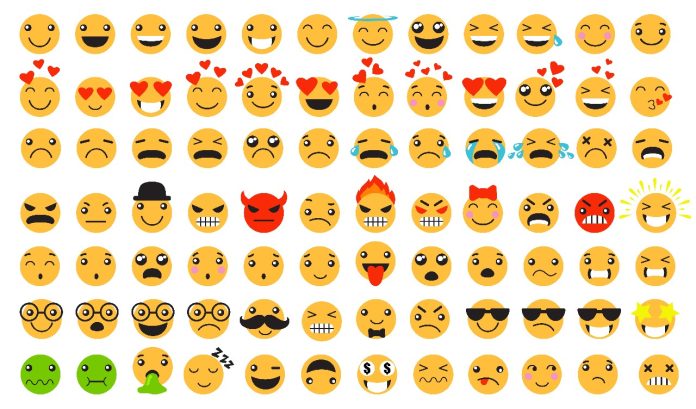In the day and age we live in, emojis have entered the social substructure. They serve quite a few purposes. Of course, they break the monotony between long text messages. Besides that, they add a lighter note to a body of text that greets us across social media. The point of it is to convey emotions, which is how it derives its name. Putting a face to emotion gives another dimension to written communication across a virtual medium. Now, there are instances where the lack of a suitable emoji makes users choose a similar emoji, which they think suits the occasion. Confusion ensues for receivers, who interpret it differently. Here, they play a problematic role by creating ambiguity rather than doing away with it.
A lot of us use certain emojis repetitively across our register, i.e., the language required to fit a writing style, to the point it becomes a major component alongside Internet slang in our online behaviour. Some tend to have favourite emojis. Well, I have them too.
Have you ever wondered how emojis can soften the blow? Yes, they act as a mode of euphemism, a mild/indirect expression replacing a harsher one to camouflage or tone down what might sound disrespectful. In that regard, graphic euphemism could be a better fit. Imagine facing the wrath of someone in person. Assuming the worst-case scenario, the degree of fury or rage could be at its peak.
On the other hand, an angry emoji, no matter how generous they’re with it, transfers only so much of that emotion to the receiver. Also, it gives them processing time, allowing them to think about what might be appropriate in such a situation and formulate their responses accordingly. This could be a downside when there’s a need to make messages more pronounced.
Let’s say you need to make an apology. Choosing to do that over a text sure offers an easy option, and there’s always a chance that things will resolve themselves. That’s because you can choose your words with careful consideration. In person, there could be a million unforeseeable factors or the fact that you’re unable to express yourself clearly in the given moment, despite having sincere intentions.
Often, we’re on the receiving end of conversations, confrontations, arguments, or the like. The other person may say exactly what they wish to, which may lean towards borderline disturbing or offensive. But we’re left without a clue how to express what we want. Perhaps all the points that could make a strong comeback in our favour seem to be amiss. In situations like these, writing to them could defuse the tension and provide you with a chance at “All’s well that ends well.” Again, it could have the opposite effect as well. Say, when you send a sorry emoji, it depends on the receiver and the point of conflict you’ve had as to how it goes down with them. When paired with written words, it speaks to them in a certain way. When presented as a standalone element, it could elicit a different reaction. Some might even regard it as an insincere effort or an attempt to get it over with, in which case they’ll believe that you don’t truly mean what you’ve sent them. It is necessary to understand how to make the best use of emojis so that they aid our communication with others. On the one hand, emojis bridge the gap between emotion and expression, on the other hand, they could widen it further.
When it comes to non-verbal cues, we miss out on them due to the lack of face-to-face interaction. Not getting to witness gestures, body language, or notice the voice changes is a given. That could place us at an advantage or a disadvantage. It gets worse when an emoji is sent as a response to someone narrating their troubles, or sorrows, describing something fervently, or seeking an elaborate reaction from our end. Maybe it leads them to think that we’re trivialising their experiences. It is not the best feeling in the world.
On the brighter side, emojis act as a reflection of closeness, a marker of familiarity and relatability among friends. Often, it works just fine without having to speak a lot of words and a symbol, which in this case is an emoji, sums up their headspace. Another function that the emojis perform is that of inclusion. They bring greater representation by showcasing different professions, gender identities, people with special abilities, those with varying skin tones and so much more. It exemplifies coexistence across virtual platforms where we’re mostly headed. When the same accommodative outlook transcends beyond the digital space to a physical space, it benefits us as a community. Today, children get exposed to technology at a much younger age. As they come across an image of inclusion in the form of emojis, they learn more about respectful representation of differences through a process of conditioning which becomes routine to them. This shows in the way they speak and behave later.
Besides the interpersonal domain, these are widely employed for promoting products and services by brands. When you see a poster with a slogan printed loftily, an emoji accompanying it adds a layer to the message, as long as it’s relevant. This is due to the sense of comfort associated with emojis since social media users are accustomed to seeing them now and then. The same applies to notifications from popular apps whose services we avail of at the drop of a hat. Swiggy, Zomato, Blinkit and the list goes on. They’re supposed to complement what these companies intend to tell us. Think of posts on Instagram or a similar platform where captions could contain emojis, to construct a narrative that engages audiences. See how intricately emojis can apply to multiple scenarios with their multifaceted connotations!





























